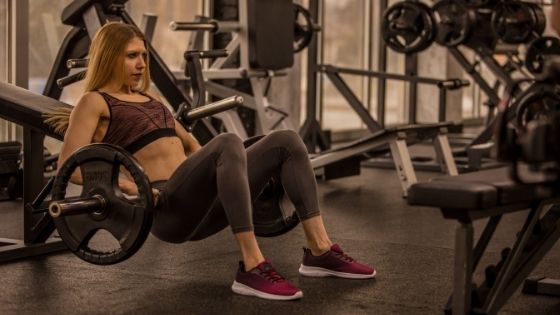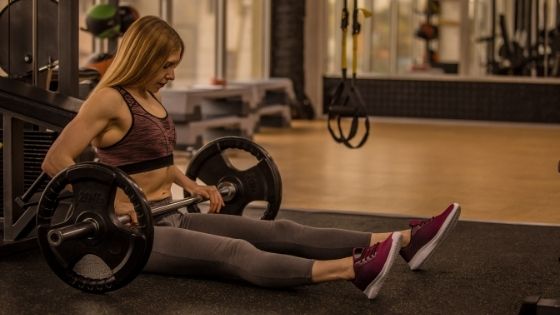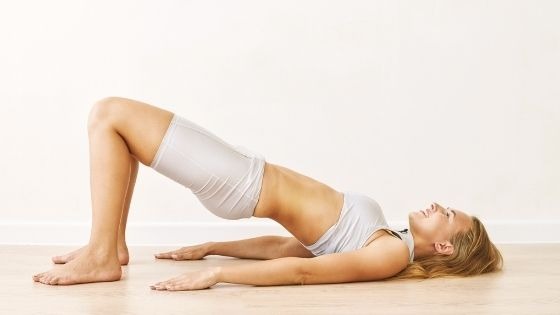HIP THRUST, The Best Exercise for a Perfect Butt!

What is Hip Thrust? What is the barbell Hip Thrust? Having a perfect body is the dream of every person, whether male or female, the ideal body is significant for every human being. After years of training, I discovered that this is a necessary exercise in any training program.
The Hip Thrust is an exercise for the buttocks designed to improve your strength, speed, and power by achieving hip extension. This exercise is essential because it strengthens the buttocks among your body's most powerful muscles.
Diets are sometimes very rigorous, exercises in the gyms, running in the park, making all kinds of sacrifices to maintain a good figure. The figure you have is going to say a lot about your health. A healthy person will quickly notice how well they are doing.
When you exercise, you usually don't give your buttocks importance. Instead, you do exercises covering the whole body, and almost everyone forgets this part.
The buttocks' function gives the hip stability, besides connecting the upper part of the body with the lower leg.
You may be interested in "How to get perfect buttocks."
How to do a barbell Hip Thrust correctly?

Some exercises favor the gluteal muscles, such as lunges, squats, etc., but they are not enough. The largest muscle group in the human body is the gluteus, so they need an exercise that isolates and works them intensively. The most recommendable activity to achieve this task is the Hip Thrust.
To execute the standard Hip Thrust correctly, one must avoid arching the back and having the gluteus and abdominal area constant tension. It is also essential to do the right range of motion to perform the movement with a strict technique.
I will explain the hip thrust technique like the study of the Strength and Conditioning Journal indicates. All you need is a bench, a bar, and some weights to perform this exercise.
- You lie on your back to support your whole back on the bench, and your feet should be on the floor at a 90-degree angle.
- You put the barbell with the weight on your hip bones (pelvis,) and with your arms, you hold the bar so that it doesn't fall.
- The exercise consists of raising the pelvis together with the weight and contracting the buttocks. This elevation must be made very controlled without the intervention of the other parts of the body.
- It would be best if you did it slowly to work in this body area.
- Avoid lifting with your legs or arching your back. The idea is to work in the buttocks area; the weight that the pelvis is going to raise helps the body's resistance.
- Also, going to work the quadriceps, calves, and hamstrings, but this will be secondary.
- The pelvis should be straight with the back, supporting the buttocks' contraction momentarily when you lift the pelvis.
- Your feet and legs should be firmly on the floor. And very important, the head should be aligned with the back and avoid any damage.
- It would be best if you did not allow your chin to rest on your chest or your head to fall off the bench. I also have three tips that will help improve the effectiveness of the exercise.
Here, I provide you with a Youtube video to help you perform hip thrusts correctly.
Related: "The glutes and hamstrings workout that'll change your butt forever"
Tips to improve your technique
Find the right height.
The first advice is to look for a height that should be neither too high nor too low. Most of the benches in gyms are usually very high, so you have to look for the lowest ones.
The ideal would be to place steps since we can regulate the height. You have to put six blocks on each side. It depends on the brand and the type of effort you have. So my recommendation for this exercise is that you look for a lower bench.
Use a good pad
The second crucial tip is that you have to use the correct pad. Unfortunately, most cushions are not usually firm enough for this exercise.
The pad should be specifically for Hip Thrust because it offers much more protection than other pillows. That allows us to perform the movement with less pressure on our iliac crests on the pelvis.
Use a shorter barbell
The third important tip is to look for a shorter barbell. Most people do it with the Olympic bar, the 20-kilogram bar. However, in the beginning, especially for beginners, this can be more difficult and tedious, so it is better to look for a shorter bar that is easier to handle because it allows us to have more control and be more comfortable.
That can have something negative, and is that if the ends of the bar are different and shorter, we may be limited when adding more discs. If this happens, you will have to look for the more massive discs.
If you are already short, that weight will move to a larger bar. But for a better start, it is better to start with a smaller bar.
Avoid arching your back.
A mistake would be to make an arch in the lumbar zone when going down. Also, to support a very high part of our back, such as leaning on the trapezes.
Finally, leave too much distance to our feet. That will overload the lumbar area, and we should avoid loading and arching in the lumbar region.
Apply the techniques correctly.
We have two ways to perform the Hip Thrust:
Constant tension
With the constant tension, we go up, controlling the movement. That does not mean we go slowly, but we have to lift quickly but hold the motion throughout the journey and make a slight pause at the top of the movement.
That helps us be more aware of the voluntary contraction in the buttocks. When we lose weight, we can control the descent. That is to say, we should not let ourselves fall until the discs touch the floor.
We must also control this descent to have the eccentric phase's benefits. The eccentric phase is also perfect for producing hypertrophy and for gaining strength.
You can even try to touch the discs on the floor slightly or not touch the disk. In this way, you will keep the tension constant in the buttocks, i.e., there will be no moment of zero resistance.
Explosive lifts
The other way you can perform the Hip Thrust is with high-speed explosive lifts. However, that can backfire if they lack experience performing the exercise. Even if you go faster and the fibers' recruitment in the buttock may be more significant, that will not translate into greater muscle hypertrophy.
If you don't control that movement, you may be shifting the force diagonally more toward your head than vertically. That is to say, by going faster and wanting to make an explosive series, you may have less time under tension and lose the centric phase. This phase is crucial for gaining hypertrophy.
Also, the movement of one's inertia affects the work on the buttocks.
Another essential point to perform a good technique is to shorten the distance from your ribcage and in your pelvis. You have to squeeze the abdomen as if you were doing an abdominal exercise. You must also tighten the gluteus in the isometric phase, which is the highest movement phase.
Finally, you must also voluntarily contract the abdomen because it helps concentrate more on the buttocks.
Place your feet correctly.
Another tip is to place your feet correctly during the execution of the Hip Thrust.
- It is vital to support the entire sole, including the big toe.
- It is also essential that you not stand on your toes or use your heel alone.
- You have to keep the sole completely supported and make force with the heels without raising the front of your foot.Â
- It would be best if you kept the toes on the ground.Â
- It is also essential that our knees do not go inwards but somewhat outwards. We must try to open the hip and make the knees point slightly diagonally to the sides. Some people are more comfortable maintaining alignment with their knees in front. Still, I recommend you try to open outward because otherwise, the lift may tend to go inward, which would be a problem.
Here is a video tutorial in which you will see the procedure of this great exercise.
Different Hip thrust variations and alternatives
You have two variants of this exercise if you want to start working your buttocks easier without using weight. We indicate them to you next:
Glute bridge

It is almost identical to Hip Thrusts, but I suggest people start the gym without using weight. Also, for women who want to train at home, the execution would be like this:
Lie on your back with your knees bent and hips supported by a rug or mat.
- Put your feet flat with your buttocks on the mat.
- Contract your body's core (abdomen), squeeze your butt while lifting your hips.
- Hold for two seconds in the upper position, squeeze hard and return to the mat with control.
- Repeat the movement for the desired number of repetitions.
- Remember that you must firmly contract and squeeze your buttocks in the concentric part of the exercise (when you are up). In this way, you will achieve greater effectiveness.
Related: "The best 10 home exercises for glutes to sculpt the perfect butt"
Single leg hip thrust
There is another variant of Hip Thrusts which you can do with a lot of weight. It's called single-leg hip thrust and it looks like this:
- You will need the help of your trainer to hold your feet set up in the rack, while he places his hands on your shoulders (not too heavy). He will let you go when you are in position.
- You will be lying on your back with one leg bent and the other straight. You will hold a weight in your hand (dumbbell or barbell) while keeping your shoulders on the ground.
- Now, you will lift your torso and the extended leg to create a straight line with your body. Remember to keep the weight as close to your hips as possible.
- Return to the starting position and repeat for the desired number of repetitions.
It is very important that you maintain a strong contraction in your buttocks during the entire movement. Remember that this variant is more difficult because you are working with one leg only.
Hip Trust with the rubber band
That is a very similar exercise to the Hip Thrust weight using a rubber band. People who train at home or start in the gym perform it.
- Lie down on an exercise mat or carpet.
- Put your feet on the floor and your knees pointing upward. Bend them at a 90-degree angle.
- Place a resistance band over your belly and across your hips.
- Hold it to the floor with your hands, one on each side.
- Pull your hips up to form a straight line from your knees to your shoulders.
- Hold this extended position while contracting your buttocks for 1 second before slowly lowering your hips to the starting position.
Low rope Hip Thrust
That is an excellent variation of the Hip Thrust and also very safe:
- You take the cable and fix the rope handle or other similar accessory to the machine on a pulley machine.
- Lower the pulley to the lowest setting
- Choose the most appropriate weight for you to execute the exercise correctly (remember that you always have to start light when you learn a new movement)
- Stand with your back to the machine.
- Grab the rope with your palms facing each other between your legs.
- Take one or two steps away from the pulley until you notice the machine plates starting to lift.
- Ensure you are far enough away so that the weight you are lifting does not touch the weight stack again.
- Put your feet in a broader posture than the width of your shoulders.
- Put your feet straight or point beyond 15-30 grades outward.
- Start the movement by bending your back slightly and pushing your hips out of the machine.
- Please do not allow the spine to bend, keep it neutral.
- Push your hips back until you feel a good stretch in your hamstrings.
- Pause for a second and reverse the movement.
- Be sure to squeeze and activate your buttocks at the top of the action.
- Repeat until you complete the desired number of repetitions.
Hip Thrust in machine
I do this exercise every day for the leg/buttock. Before, I was the only girl doing it at the gym; now, I've seen two different girls come up to learn and do it every day on their buttocks.
At the beginning of practicing this movement, my hips were a little bit bruised (I was putting too much weight on them), now it has stopped bruising.
That is so easy when you put on the right weight, find out what position to put yourself in (from a distance) and pay attention to your form. It's effortless.
I position myself so that the seat is right at the bottom of my shoulder blades, I also keep my neck tucked at the top of the movement, making the motion with my hips.
I am also paying attention not to overextend myself and not put too much pressure on my back, as you would with the traditional Hip Thrust exercise.
Hip thrust in Multipower or Smith machine
I do the hip thrust with free weight and in multipower. It's not uncommon in my gym to see people doing both, and I don't feel that doing it with free weight is any more difficult.
The Smith machine or the Multipower isolates my buttocks much more and moves much more weight safely.
How to hip thrust on a smith machine? I've included a video instruction below for your convenience.
What does a hip thrust work?
Hip thrusts concentrate on the gluteal complex's hip extensor muscles, particularly the gluteus Maximus, medius, and minimus. Hip extensors are the muscles that straighten your leg from a bent position.
The Hip Thrust works almost every muscle in the lower body, including:
- Buttocks.
- Quadriceps.
- Biceps femoral.
- All the calves (calves and tibia)
This exercise flattens the belly, helps tone the muscles that define the six-pack, and gives you a more defined waist by working the obliques.
The Glute Bridge will also help you excel in other exercises. Strengthening the buttocks feeds more power, which improves training on all other platforms. So whether you're running, squatting, or lunging, you'll see improvements in your repetitions.
Conclusion
The Hip Thrust is the ideal exercise for your buttocks. You must be constant and disciplined with it.
This way, you will get the buttocks you have wanted so much. This exercise is very intense and will work better on your major, minor and medium buttocks.
Compared to the Glute Bridge, the pelvis' elevation on the floor and the Hip Thrust are more intense without any load. As a result, it makes your body forced to work with a greater demand on the buttocks.
I highly recommend you start the exercises calmly and progressively. For example, you can start with the Butt Bridge first, go to the Hip Thrust without a load or with a band, and finally incorporate the exercise's necessary weight.
This way, you get your body used to that kind of exercise to which you will expose it, and you avoid possible injuries by not taking the necessary safety measures.
It is not an easy exercise to perform, and at the same time, it is pretty demanding, but it will give you incredible results after some training time.
DISCLAIMER: buildyourbody.org does not provide medical advice, examination, and diagnosis.
Medically reviewed and approved by Nataniel Josue M D.
